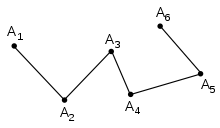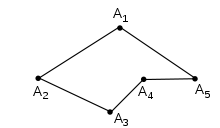Chain (algebraic topology)
In algebraic topology, a k-chain is a formal linear combination of the k-cells in a cell complex. In simplicial complexes (respectively, cubical complexes), k-chains are combinations of k-simplices (respectively, k-cubes).[1][2][3] Chains are used in homology; the elements of a homology group are equivalence classes of chains.
Integration on chains
Integration is defined on chains by taking the linear combination of integrals over the simplices in the chain with coefficients (which are typically integers). The set of all k-chains forms a group and the sequence of these groups is called a chain complex.
Boundary operator on chains


The boundary of a chain is the linear combination of boundaries of the simplices in the chain. The boundary of a k-chain is a (k−1)-chain. Note that the boundary of a simplex is not a simplex, but a chain with coefficients 1 or −1 – thus chains are the closure of simplices under the boundary operator.
Example 1: The boundary of a path is the formal difference of its endpoints: it is a telescoping sum. To illustrate, if the 1-chain is a path from point to point , where , and are its constituent 1-simplices, then
Example 2: The boundary of the triangle is a formal sum of its edges with signs arranged to make the traversal of the boundary counterclockwise.
A chain is called a cycle when its boundary is zero. A chain that is the boundary of another chain is called a boundary. Boundaries are cycles, so chains form a chain complex, whose homology groups (cycles modulo boundaries) are called simplicial homology groups.
Example 3: A 0-cycle is a linear combination of points such that the sum of all the coefficients is 0. Thus, the 0-homology group measures the number of path connected components of the space.
Example 4: The plane punctured at the origin has nontrivial 1-homology group since the unit circle is a cycle, but not a boundary.
In differential geometry, the duality between the boundary operator on chains and the exterior derivative is expressed by the general Stokes' theorem.
References
- ↑ Hatcher, Allen (2002). Algebraic Topology. Cambridge University Press. ISBN 0-521-79540-0.
- ↑ 1950-, Lee, John M., (2011). Introduction to topological manifolds (2nd ed.). New York: Springer. ISBN 1441979395. OCLC 697506452.
- ↑ Tomasz,, Kaczynski, (2004). Computational homology. Mischaikow, Konstantin Michael,, Mrozek, Marian,. New York: Springer. ISBN 9780387215976. OCLC 55897585.